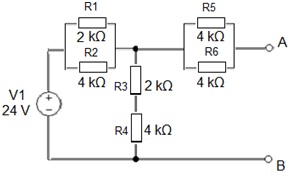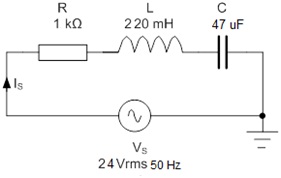Reference no: EM132518038
Unit 3 Engineering Science - Pearson BTEC Level 4 Higher National Certificate
Assignment - Analyse applications of A.C./D.C. circuit theorems, electromagnetic principles and properties
Purpose of this assignment
Acquire a fundamental understanding of the electrical principles that underpin the design and operation of a large range of engineering equipment and systems.
This unit (Unit 3) will develop learners' understanding of the key electrical concepts that relate to all aspects of engineering. In particular, learners will study electromagnetic principles & properties in learning outcome 4 of Unit 3 begin by refreshing learners' understanding of resistors connected in series/parallel and then developing the use of Ohm's law and Kirchhoff's law to solve problems. Circuit theorems are also considered for resistive networks only together with a study of the characteristics of series RLC circuits.
This will be achieved by fulfilling the following learning outcomes of Unit 3:
4. Be able to analyse applications of A.C./D.C. circuit theorems, electromagnetic principles and properties.
Scenario
As a junior maintenance engineer, your line manager requires you to take measurements and analyse electromagnetic principles & properties from an electronic circuit board, that is being manufactured for an aerospace project, and produce a report on your findings. You are also required to carry out calculations using Ohm's and Kirchhoff's laws to verify/analyse your measured values; evaluate the characteristics of series RLC circuits . The information gained from this activity will be used to select the most appropriate types of capacitors/inductors to be used on the circuit boards of the aerospace project.
Problem Task 1
Calculate currents and voltages in circuits using circuit theorems; Describe how complex waves are produced from sinusoidal waveforms; solve problems on series R, L, C circuits with A.C. theory; calculate currents and voltages in circuits using Kirchhoff's laws; contrast principles and applications of electromagnetic induction; examine and problems on series- parallel R, L,C circuits using A.C. theory.
a)
For the DC network shown in Figure 1, determine the following:
i) Thevenin's equivalent voltage
ii) Thevenin's equivalent resistance
iii) Sketch the Thevenin's equivalent circuit (clearly labelled)
iv) Norton's equivalent current
v) Norton's equivalent resistance
vi) Sketch the Norton's equivalent circuit (clearly labelled)
vii) Use Multisim to construct the circuit and by measurements verify your calculated values (clear copies of Multisim screenshot/s must be attached to your answers).

Figure 1. DC network
b)
Apply Fourier series rules to transform a fundamental sinusoidal wave with amplitude of 60 V and a frequency of 10 Hz into a triangular and a sawtooth waveform respectively. For each waveform you should:
i) Describe the following characteristic:
1) Frequency components
2) Relative Amplitudes of Harmonics
ii) Calculate the relevant harmonic amplitude and frequency up to and including the 15th harmonic
iii) Use MS Excel to plot Harmonic Spectrum of each waveform (both as bar chart, and scattered graph).
c)
Consider the AC supplied single-phase RLC series circuit shown in Figure 2. Calculate:
i) Total impedance
ii) Total current
iii) Voltages across R, L, and C
iv) Use Multisim to construct the circuit and by measurements verify your calculated values for total current and voltages across R, L, and C (clear copies of Multisim screenshot/s must be attached to your answers).

Figure 2. Single-phase RLC Series Circuit
d)
i) A rectangular coil, shown in Figure 3, has 25 turns and an area of 2.5 x 10-4 m2 is place in a magnetic field of strength 6.8 x 10-6 Tesla. Calculate the flux linkage when the plane of the coil is:
1) Parallel to the magnetic field
2) Perpendicular to the magnetic field
3) Calculate the size of the induced e.m.f.

Figure 3. rectangular coil
ii) An aircraft flies from East to West. In what direction is the induced
e.m.f. due to the cutting of the Earth's horizontal magnetic field? You should support your answer with Faraday's and Lenz's Laws where applicable.
e)
The combine RLC network shown in Figure 4, consisting of a resistor of 2.2kΩ, a capacitor of 0.047uF and an inductor of 500mH is connected across an A.C supply voltage which has a constant output of 12 Vrms at 1kHz frequency. You are expected to determine the potential difference (voltage drop) between points A and B in this circuit by undertaking the following instructions:
i) Write the outline of the problem-solving strategy you intend to take i.e. list the sequential steps you would take, in order to solve the problem.
ii) Show all stages of calculations in each step.
iii) Support your calculated values with the help of voltage and impedance triangles.
iv) Use Multisim to construct the circuit and by measurements verify your calculated values (clear copies of Multisim screenshot/s must be attached to your answers). Any discrepancy between the calculated and measured values must be discussed, evaluated, and justified.

Figure 4. Combine RLC circuit
Assignment - Determine parameters within mechanical engineering systems
Testing materials using scientific method
Scenario
As a junior maintenance engineer, your line manager requires you to investigate a faulty design of complex loading system where two rectangular beams are connected through different tie bars. The whole system is holding a dive motor which runs a drive shaft. You are required to carry out all calculations and make an effective judgements about the suitability of the loading system demonstrating the selection / design and application of appropriate methods/techniques to solve a given problem. In order to solve this problem you will be required to apply your prior knowledge of forces and moment when simply supported beam has several loads acted upon it.
Problem Task 1
Determine the support reactions of a beam carrying a concentrated load and a uniformly distributed load; Use Archimedes' principle in contextual engineering applications; Determine through practical examples the change within a solid material when exposed to temperature variations; Determine unknown forces by applying D'Alembert's principle to a free body diagram; Critically compare how changes in the thermal efficiency of a heat transfer process can affect the behavioural characteristics of a mechanical systems.
Part 1:
i. You have been tasked by your line manager to investigate a simply supported beam length of A meter, and to calculate the support reactions which is subject to a uniformly distributed load of 60N/m across the full length of the beam and a concentrated load of 60kN positioned 2m from the left hand end.
ii. Within your industry, under you supervision, an iron steel pipe length of B meter is going to be manufactured and hardened, which will be driven into the ground later on with the help of a pile driver hammer. To demonstrate your understanding of dimensional change within a solid material when exposed to temperature variations, you have been tasked to determine the length of the pipe under working conditions when the temperature is 300
°C. Assume the coefficient of linear expansion of iron is 12 ×10-6 K-1 at room temperature 200 C.
iii. A piledriver of mass C kg falls freely through a height of 1.5 m on to the above steel pole/pipe of mass 200 kg. If, at impact, 3 kJ of energy are lost due to heat and sound, the remaining energy being possessed by the pipe and driver as they are driven together into the ground a distance of 200 mm, using D'Alembert's principle applied to a free-body you are tasked to determine:
a. the velocity with which the driver hits the pile.
b. the common velocity immediately after impact,
c. the average resistance (unknown forces) of the ground, and
compare and contrast the use of D'Alembert's principle with the principle of conservation of energy to solve the engineering problem, and make a conclusion in support to your answer.
Part 2:
Pistons are forged at you workplace. You are required to maintain a high metallurgical precision of those components. Being a junior engineer within your organisation, your line manager wants you to state Archimedes' Principles establishing the fact stating the relationship (formulae) when the weight of liquid displaced is equal to the weight of the floating body, and using this formula you have been tasked to solve an engineering application as follows:
Component weighs D N in air and 2.925 N when completely immersed in water of density 1000 kg/m3. Calculate the volume of the body, (b) the density of the body and (c) the relative density of the body. Assume the gravitational acceleration as 9.81 m/s2.
Part 3:
Jet engines are used in your organisation. A jet engine releases E J of energy per cycle and performs 700 J of work. You have been tasked to work out and explain in written to the management the following:
i. How much heat is absorbed by this engine per cycle?
ii. What is the thermal efficiency?
iii. How much work can this engine perform in 60 cycles?
iv. If the engine completes each cycle in 0.3 seconds, what is the power rating of the engine?
v. If the thermal efficiency is 20%, how much work will be performed by the jet engine and critically compare how changes in the thermal efficiency of a heat transfer process can affect the behavioural characteristics of a mechanical system.
|
Student
|
A
|
B
|
C
|
D
|
E
|
|
1
|
8
|
20
|
450
|
3.760
|
390
|
|
2
|
9
|
21
|
460
|
3.759
|
395
|
|
3
|
10
|
22
|
470
|
3.758
|
400
|
|
4
|
11
|
23
|
480
|
3.757
|
405
|
|
5
|
12
|
24
|
490
|
3.756
|
410
|
|
6
|
13
|
25
|
500
|
3.755
|
415
|
|
7
|
14
|
26
|
510
|
3.755
|
420
|
|
8
|
15
|
27
|
520
|
3.754
|
425
|
|
9
|
16
|
28
|
530
|
3.753
|
430
|
Attachment:- Engineering Science.zip